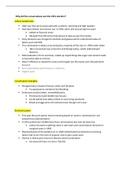Summary
Summary of chapter 4 conservative domination 1951-64 for OCR Britain
- Course
- Institution
- Book
Summary of Chapter Four: Britain's position in the world 1951-97. These useful pages summarise the key points in the chapter in as few words as possible. A great place to start revision from rather than reading through the huge textbook. These notes helped me achieve an A*. Apologies for any spell...
[Show more]




